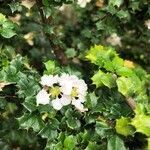Shrublet, 0.5-2.5 m high. Twigs terete, when young sparsely set with pale, appressed hairs; internodes 1-1.5(-2) cm. Leaves either along the twig and then with a few, mucronate, marginal teeth, margin between the teeth revolute, or on dwarf shoots, and then entire, coriaceous, suborbicular to elliptic, 1-1.5(-2) by 0.75-1.25(-1.5) cm; base rounded to truncate; top rounded to slightly notched; petiole and margin sometimes sparsely haired; surfaces glabrous, shiny and with prominent venation above; petiole 1-2 mm. Stipules small, linear, near the base of the petioles. Flowers on the dwarf shoots, axillary, single or paired, white to pale pink or light red, glabrous, faintly scented. Pedicels c. 1½ cm, articulation in the lower half, marked by 2 small bracteoles. Calyx with 6-10, flat, elliptic glands c. 1.5 mm in diam., sepals 2-3 mm long, blunt. Petals slightly differing in size, claw 2-4 mm, limb 5-7 by 3-7 mm. Filaments sometimes slightly unequal in length, c. 3 mm, 2 opposite filaments thicker and bearing anthers about twice the size of the others. Two styles ascending in a bow, 5 mm, the third one abortive, 2 mm; stigma c. 1 mm wide. Fruit (not seen) red, 8-10 mm long, only 1-2 mericarps developing.
More
A small evergreen shrub. The bark is light coloured. It grows 75 cm high and 75 cm wide. The leaves are 25 mm long and dark glossy green. They have deep teeth and sharp prickles. The flowers are pink to mauve. The fruit is small and red-purple when ripe. They are 6-12 mm wide.

